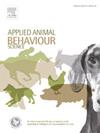Do lambs differentiate the odor of their mother from that of an alien ewe? Focus on inguinal wax
IF 2.2
2区 农林科学
Q1 AGRICULTURE, DAIRY & ANIMAL SCIENCE
引用次数: 0
Abstract
Ewes bear scent glands located near the udder which smelly secretion is interesting to newly-born lambs searching a teat to suck on. This glands’ secretion – inguinal wax (IW) – was found to be reactogenic to lambs before they initiate suckling from the dam. The present study aimed to further assess whether IW odor affects two vital aspects of newborn lambs’ behaviour: orienting and engaging suckling. First, forty-six lambs were tested in two-choice odor tests contrasting i) own mother's Inguinal Wax (IW-M) vs. unfamiliar mother's Inguinal Wax (IW-nM), ii) IW-M vs. control and iii) IW-nM vs. control, to measure their differential orientation to maternal IW odor presented against either IW from another dam or a control. Second, a bottle-feeding test (n = 41 lambs) assessed lambs’ elicitation of suckling from IW-odorized vs. control bottles. Relative to the control, IW odor enhanced lambs' orientation during the two-choice odor test, but without differentiation of maternal IW from non-maternal IW. Otherwise, lambs did not engage more suckling on a bottle when odorized with maternal IW relative to a control bottle. Some aspects of lambs’ responses were differentiated by sex, but this effect was independent on odor condition. In sum, this preliminary study indicates that ovine IW is somehow inherently attractive to lambs before they associate it with suckling.
求助全文
约1分钟内获得全文
求助全文
来源期刊

Applied Animal Behaviour Science
农林科学-行为科学
CiteScore
4.40
自引率
21.70%
发文量
191
审稿时长
18.1 weeks
期刊介绍:
This journal publishes relevant information on the behaviour of domesticated and utilized animals.
Topics covered include:
-Behaviour of farm, zoo and laboratory animals in relation to animal management and welfare
-Behaviour of companion animals in relation to behavioural problems, for example, in relation to the training of dogs for different purposes, in relation to behavioural problems
-Studies of the behaviour of wild animals when these studies are relevant from an applied perspective, for example in relation to wildlife management, pest management or nature conservation
-Methodological studies within relevant fields
The principal subjects are farm, companion and laboratory animals, including, of course, poultry. The journal also deals with the following animal subjects:
-Those involved in any farming system, e.g. deer, rabbits and fur-bearing animals
-Those in ANY form of confinement, e.g. zoos, safari parks and other forms of display
-Feral animals, and any animal species which impinge on farming operations, e.g. as causes of loss or damage
-Species used for hunting, recreation etc. may also be considered as acceptable subjects in some instances
-Laboratory animals, if the material relates to their behavioural requirements
 求助内容:
求助内容: 应助结果提醒方式:
应助结果提醒方式:


